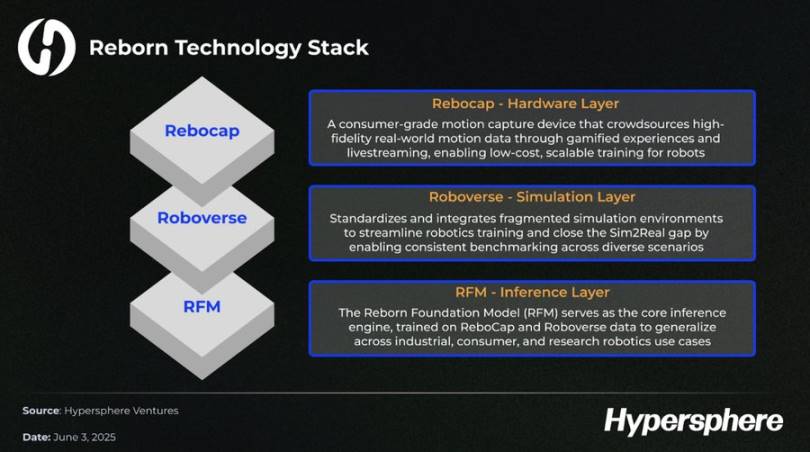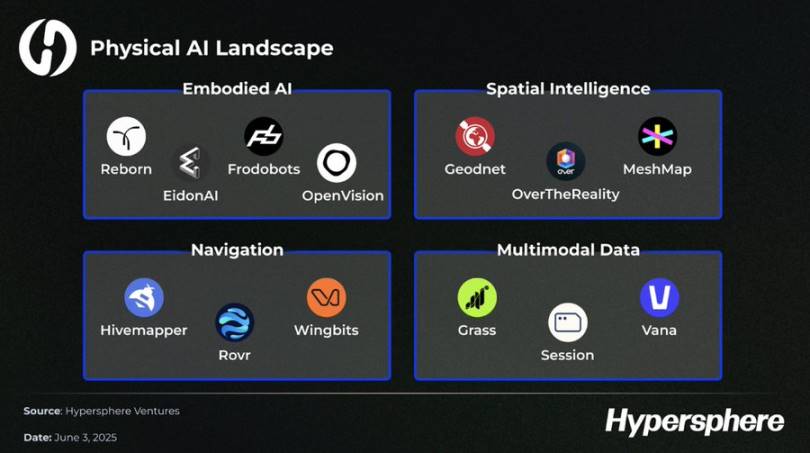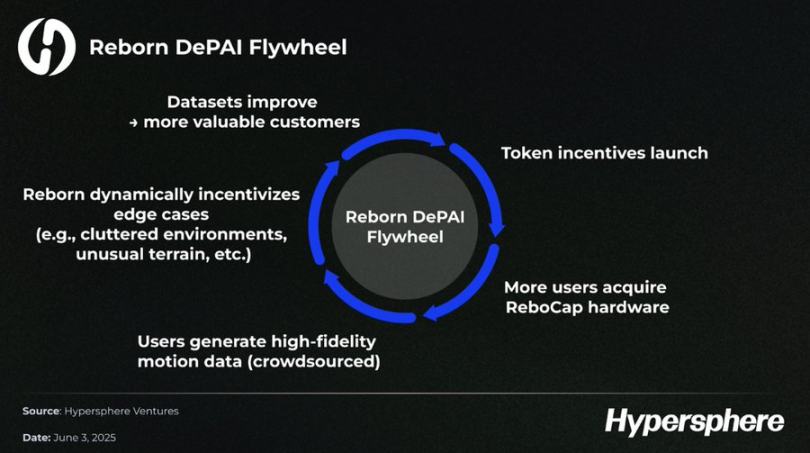The data required for humanoid robots needs to be cost-effective, scalable, and composable, and the token incentive model of cryptocurrency can fill the most urgent gap currently.
Written by: @brezshares
Translated by: AididiaoJP, Foresight News
Background Summary
General humanoid robots are rapidly transitioning from science fiction to commercial reality. Thanks to the decline in hardware costs, a surge in capital investment, and advancements in movement and flexibility, the field of AI computing is brewing the next round of significant transformation.
While AI cloud computing and hardware facilities are becoming increasingly popular, providing a low-cost manufacturing environment for robotics engineering, the field is still limited by a lack of training data.
Reborn attempts to utilize DePAI for decentralized high-fidelity motion and synthetic data, and to build a foundational model for robots. Project members come from institutions such as the University of California, Berkeley, Cornell University, Harvard University, and Apple.
Humanoid Robots: From Science Fiction to Reality
The commercialization of robots is not a new concept, as seen with the iRobot Roomba vacuum cleaner launched in 2002, or the popular Kasa pet camera in recent years, but they typically have single-function designs. With the development of AI technology, robots are gradually evolving from single-function machines to multi-purpose devices capable of operating in unstructured environments.
In the next 5 to 15 years, humanoid robots will gradually expand from basic tasks like cleaning and cooking to more complex fields such as concierge services, firefighting, and even surgery. The following three major trends are making this vision a reality:
Rapid market expansion: Over 100 companies worldwide are engaged in humanoid robot R&D, including well-known enterprises like Tesla, Unitree, Figure, Clone, and Agile.
Hardware technology breakthroughs "in the uncanny valley": The next generation of humanoid robots moves smoothly and naturally, capable of rich interaction with humans. For example, the Unitree H1 can walk at a speed of 3.3 meters/second, far exceeding the human average of 1.4 meters/second.
New paradigm of labor costs: By 2032, the operating costs of humanoid robots are expected to be lower than the wage levels of the average American workforce.
Bottleneck: Scarcity of Real-World Training Data
Despite the broad prospects for humanoid robots, large-scale deployment will still be limited by the quality and scale of training data.
Other AI fields (such as autonomous driving) have addressed data issues through onboard cameras and sensors. For instance, Tesla and Waymo train their autonomous driving systems using vast amounts of real driving data. Waymo can conduct real-time training on the road and has a robot coach in the passenger seat during training.
However, consumers are less willing to actively provide data when using robots, and they are unlikely to tolerate the presence of a "robot nanny." Therefore, humanoid robots must be high-performing right out of the factory, making data collection before deployment a critical challenge.
While each training mode has its own scale unit, the scale of robot training data lags behind other AI fields by orders of magnitude:
GPT-4: Training data includes over 150 trillion texts.
Midjourney/Sora: Relies on billions of annotated video-text pairs.
Robot datasets: The largest scale is only about 2.4 million motion clips.
This disparity explains why robotics technology has yet to establish a true foundational model, as data simply cannot be collected. Traditional data collection methods struggle to meet the demand:
Simulation training: Low cost but lacks niche real-world cases (i.e., the "Sim2Real gap").
Online videos: Lack the force feedback or proprioceptive data required for robot learning.
Real data collection: Requires manual remote control, with the cost of a single machine exceeding $40,000 and difficult to scale.
Reborn attempts to acquire real-world data in a low-cost and efficient manner through a decentralized model, effectively addressing the Sim2Real gap.
Reborn: A Full-Stack Solution for DePAI
Reborn is committed to building a vertically integrated physical AI software and data platform, with the core goal of solving the data bottleneck for humanoid robots, but the vision extends far beyond that. Through proprietary hardware, multimodal simulation infrastructure, and foundational model development, Reborn aims to be a full-stack driver in the field of intelligent humanoid robots.
ReboCap: Crowdsourced High-Fidelity Motion Data
ReboCap is a low-cost motion capture device developed by Reborn, with over 5,000 units sold and a monthly active user (MAU) count of 160,000.

Reborn achieves data collection with better economic efficiency than other alternatives.
Users generate high-fidelity motion data through AR/VR games and receive online incentives. This model not only attracts gamers but is also used by digital streamers to drive real-time digital avatars. This natural cycle of interaction completes scalable, low-cost, and high-fidelity data generation.
Roboverse: Unified Multimodal Simulation Platform
Roboverse is a multimodal simulation platform designed to unify disparate simulation environments. Current robot simulation tools (such as MuJoCo, NVIDIA Isaac Lab) have varying functions but are incompatible, severely hindering R&D efficiency. Roboverse establishes standardized protocols through simulators, creating a shared virtual infrastructure for developing and evaluating robot models. By providing a unified development and evaluation platform, it enhances model compatibility.
Reborn Foundational Model (RFM)

Reborn Tech Stack
The most critical component of the Reborn full stack is the Reborn Foundational Model (RFM). RFM is one of the first foundational models designed specifically for robots, aiming to become the core infrastructure of DePAI. This is similar to traditional foundational models aimed at LLMs, such as OpenAI's o4 or Meta's Llama, but RFM is focused on robots.
ReboCap, Roboverse, and RFM build a strong moat for Reborn. By combining the real data from ReboCap with the simulation capabilities of Roboverse, RFM can train high-performance models that adapt to complex scenarios, supporting diverse applications for industrial, consumer-grade, and research robots.
Reborn is advancing the commercialization of technology and is currently collaborating with Galbot and Noematrix on paid pilot projects, as well as establishing strategic partnerships with Yushu Technology, Booster Robotics, Swiss Mile, and Agile Robots. The Chinese humanoid robot market is rapidly growing, accounting for approximately 32.7% of the global market share. Notably, Yushu Technology holds over 60% of the global simulation robot market share and is one of the Chinese humanoid robot manufacturers planning to produce over 1,000 units by 2025.
The Role of Cryptocurrency in DePAI
Cryptographic technology is enabling a complete vertical stack for DePAI.

Reborn is a leading project in the DePAI field.
The DePAI project ensures open, composable, and permissionless scalability through token incentives, achieving efficient decentralized data collection and incentive models.
Reborn has not yet issued tokens, but the token economics could accelerate Reborn's large-scale adoption. Once the token incentive mechanism is launched, network participation is expected to grow rapidly:
Token incentives: Users earn token rewards by purchasing ReboCap, while robot companies pay for data, creating a positive feedback loop.
Edge case mining: Dynamic incentive mechanisms encourage users to contribute high-value edge case data, filling the Sim2Real gap.

Reborn's DePAI growth flywheel
Data is Key
The true competitive advantage of humanoid robots lies in data and models. Specifically, it is the scale, quality, and diversity of the intelligent data used to train these machines.
The "ChatGPT moment" for humanoid robots will not be led by hardware companies, as hardware deployment faces inherent challenges such as high costs and long cycles. The viral spread of robotics technology is fundamentally constrained by costs, hardware availability, and logistical complexities, whereas purely digital software like ChatGPT is not subject to such constraints.
Core Conclusion: Data is the Decisive Factor
The real turning point will come from the advantages of data and models after costs decline. The data required for humanoid robots needs to be cost-effective, scalable, and composable, and the token incentive model of cryptocurrency can fill the most urgent gap currently. Reborn transforms ordinary people into "motion data miners" through the cryptocurrency token incentive model.
免责声明:本文章仅代表作者个人观点,不代表本平台的立场和观点。本文章仅供信息分享,不构成对任何人的任何投资建议。用户与作者之间的任何争议,与本平台无关。如网页中刊载的文章或图片涉及侵权,请提供相关的权利证明和身份证明发送邮件到support@aicoin.com,本平台相关工作人员将会进行核查。




